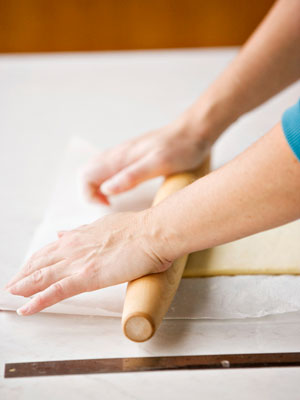Tomorrow is a big day for Amy Snider, my friend, colleague and occasional guest blogger on this board.
I love that she and her fiancé Tim have planned a wedding that reflects who they are and what they like do. The wedding is to be outdoors on Amy’s parent’s sheep farm and instead of formality and dancing, there will be Bermuda shorts, lawn bowling and croquet. On the menu is one of her Dad’s lambs and for dessert they’ll have lots and lots of pies. That’s right, despite intense peer pressure from people like me, they’re foregoing cake to have their favourite dessert instead. I like them all the better for it!
So, in honour of this celebration, I offer you a recipe for one of my favourite pies. I hope you’ll make it tomorrow and toast Amy and Tim’s happiness when you take your first bite:
Silky Lemon Meringue Pie
Crust:
1/2 cup (125 mL) butter
1 pkg (250 g) softened brick-style cream cheese
2 tbsp (30 mL) icing sugar
2 cups (500 mL) all-purpose flour
Filling:
1/2 cup (125 mL) butter
1 cup (250 mL) granulated sugar
3/4 cup (175 mL) lemon juice
pinch salt
6 egg yolks
1 cup (250 mL) sour cream
Meringue:
1/3 cup (75 mL) granulated sugar
4 egg whites
1/4 tsp (1 mL) cream of tartar
Pastry: Preheat the oven to 375ºF (190ºC). Beat the butter and cream cheese until smooth. Add the sugar and mix on low. Add the flour mixture and stir until combined and crumbly. Shape into a ball and knead two or three times or until smooth. Roll thinly and fit 9-inch (23 cm) pie plate. Refrigerate for 15 minutes. Poke all over with a fork. Line with parchment paper and fill with pie weights. Bake for 15 minutes. Remove paper and weights and bake for 10 minutes or until golden.
Filling: Melt the butter in a saucepan set over medium heat. Remove from the stove and whisk the sugar, lemon juice and salt. Whisk in the egg yolks and cook, stirring constantly with a wooden spoon, until mixture comes to a boil. Reduce the heat and cook, stirring, until thick and mounding on the spoon. Cover and bring to room temperature with waxed paper touching the surface of the filling. Gently stir in sour cream and scrape into prepared pastry.
Meringue: Preheat the oven to 375F (190C0. Place egg whites in a clean, dry bowl and beat until frothy. Add the cream of tartar and continue beating. Add sugar, a spoonful at a time, until eggs are full and glossy. Spoon over top of filling and spread to the edge of the crust. Place in oven. Bake for 5 to 6 minutes or until golden. Makes 8 servings.




 Posted by danamccauley
Posted by danamccauley  Just like
Just like  Since so many bloggers are taking advantage of the numeric poetry of tomorrow’s date (3.14= ∏) by making
Since so many bloggers are taking advantage of the numeric poetry of tomorrow’s date (3.14= ∏) by making  As much as I love my own family and as glad as I am to have a government holiday today, I still want to change the name of our holiday from Family Day to Pie Day. I’ve already
As much as I love my own family and as glad as I am to have a government holiday today, I still want to change the name of our holiday from Family Day to Pie Day. I’ve already 
 Welcome to my blog! Have a look around, feel free to post some comments and
Welcome to my blog! Have a look around, feel free to post some comments and  Please subscribe to my blog and never miss a posting.
Please subscribe to my blog and never miss a posting. Hungry for info on the latest food trends?
Hungry for info on the latest food trends? 